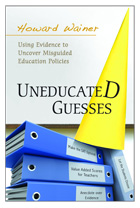 |
Gymnastics of the Mind: Greek Education in Hellenistic and Roman Egypt
by Raffaella Cribiore
Princeton University Press, 2001, $39.50; 288 pages.
In Rome, toward the end of the 1st century C.E., Quintus Sulpicius Maximus, an 11-year-old boy, won honorable mention in a poetry contest by improvising some 43 verses in ancient Greek on a mythological theme. When shortly thereafter the talented boy succumbed to a disease, his devoted parents made sure that his verses were inscribed on a grave monument, which showed him in his toga holding a book-roll in his left hand. Too bad that Maximus, unlike his namesake the gladiator, will never be the subject of an award-winning film.
Nonetheless, we can learn something about ancient education from young Maximus’s monument. Maximus, whose first language was presumably Latin, had learned to read Homer and other epic poets in Greek. He could compose in a metrical pattern that followed strict conventions. He had studied his mythology and knew how to construct an argument. Although the hexameters that young Maximus composed are not notable for their originality, either in style or content, his parents went to the great expense of having them preserved in stone. They were wealthy and proud of an achievement that would enable the boy to hold his head high among the lifeless shades in the Lower World. In ancient Rome, education was accessible only to those who could afford it, and only a small fraction of the population was able to read. Nonetheless, education mattered to the elite, then as now, and the purposes of an education were both cultural and practical.
We cannot discover from literary sources alone exactly how and why young Maximus was educated. Educated Greeks and Romans wrote much more about the final stages of rhetorical training than they did about the early stages of development. To learn about the practical details of elementary education, we need to turn to the students themselves and to their anxious parents. They recorded their thoughts in letters, which were written on papyrus. Since papyrus was preserved in the dry climate of Egypt, but lost in damper climates, most of what we know about elementary education comes from Greek settlements in that country. Almost all of the letters that have been preserved were written in Greek, even when the writers were Egyptians. They are difficult sources to work with. Fortunately, Raffaela Cribiore, associate curator of papyri at Columbia University and the author of a specialized study, Writing, Teachers, and Students in Graeco-Roman Egypt (1996), has the considerable expertise needed to make sense of the letters and bring them to life. Her new book, Gymnastics of the Mind, makes the complex and foreign world of ancient education accessible to nonclassicists, provided that they have at least some background knowledge of the ancient world.
Cribiore gives a detailed account of how children learned to write and read. Writing came first. Children copied letters and phrases, apparently without always understanding what they were copying. Then they learned to read by pronouncing nonsense syllables formed by combining consonants with vowels, such as ba-be-bi. Then they learned to decipher words and phrases, specially prepared for them by their teacher. Learning to read a sentence or paragraph required greater skill, even if it was written in a clear hand on a clean surface, because words in ancient texts were not separated from one another, lower-case letters were not used, and punctuation was at best sporadic. The accents and other diacritical marks we now use to write ancient Greek are comparatively late inventions. In antiquity even skilled readers needed to mark their texts. As Cribiore points out, the Greek word for reading, anagignoskein, literally means “know again.” To read is to recognize and recollect.
If a student could learn to read, he or she would then copy texts and take dictation, most often short pithy phrases, including some from the great ancient poets. The Greeks used the letters of the alphabet plus three additional characters to represent numbers, and some students would learn at this stage the multiplication tables and fractions. One of the surprises in this book is that parents occasionally sent their daughters as well as their sons through these initial stages of education. There were no schools, at least in our sense of the word. Schole, the ancient word from which our word school derives, literally means “leisure.” In other words, learning was available only for the rich, people with the wealth to afford free time. A small group of students met at the house of a teacher. As in a one-room schoolhouse, they were not divided into grades, and they were kept in line by the use of physical force. Most of the teachers (but not all) in the elementary stages were men. It was a trade that might be passed on from generation to generation in one family.
Only a relatively small number of students who learned to read advanced to the next stages of education, where they were taught by grammarians, teachers who were proficient in letters (grammata)–that is, literature. These teachers (and their students) were almost always male. They studied and memorized long passages from the works of the great Greek poets who had lived centuries before their own time. The most popular text, even in Egypt, was the Iliad, particularly Book 2, which contains the Catalogue of Ships, the list of all the heroes who came to Troy. The grammarians preferred Euripides to the other tragedians, because his language was simpler and his style more rhetorical. Their favorite among his dramas was a play that few people today have even heard of, the Phoenician Women. It contains some fine set speeches, along with a fast-moving account of the fate of Oedipus and his children.
By committing at least large portions of these texts to memory, students acquired a ready store of poetic phrases and vocabulary. They also learned how to structure a speech and present their arguments. They learned how to give a “true” account of a word (etymologia) by using puns to make it mean whatever would best suit their purposes. By memorizing the words of others, they learned how to structure the elements of their own compositions. It was this kind of education that the precocious young Maximus drew on when he composed his remarkable mythological “impersonation.” It is not a curriculum that would appear to have encouraged exploration or originality, and it would not have won the approval of John Dewey. Nonetheless, as Cribiore points out, it instilled a lasting respect for hard work. The same learning, drill, and impersonation lie behind the work of the greatest poets of the time, Virgil, Horace, and Ovid, to name just a very few.
-Mary Lefkowitz is a professor of classical studies at Wellesley College and the author of Not Out of Africa: How Afrocentrism Became an Excuse to Teach Myth as History.





